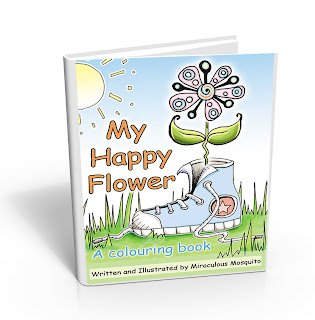 |
| 'My Happy Flower' Printable Colouring and Activity Book. |
 |
Click the image to see the different pages
in 'My Happy Flower' Colouring
and Activity Book. |
How does a little flower end up growing in a shoe, and more importantly...whose shoe is it?
I am now selling my Happy Flower 17 page printable colouring and activity book in my online shop for a mere $6.
Designed by a former teacher with 10 years of experience, and a current homeschooler with 7 years of experience. This is great resource for anyone interested in making learning fun and enjoyable for children of a variety of ages. This book and the ideas below can be adapted for children of any age between preschool and middle school.
After purchase, the printable will automatically be sent as a zip file to your email address.
Buy Now $6 USD
How To Use This Book - Ideas for Teachers and Parents:
- Discuss with children what they do when they see a pretty flower growing from a plant or tree. Do they pick it, or leave it where it is?
- What happens to the flower when you take it off the plant? Discuss the reasons why a flower dies when it is separated from the plant.
- What about other objects in nature, such as shells on the beach, a nest in a tree, or old logs on the floor of the forest...should we pick them up, or leave them where they are? What sort of animals might live in them, and how would they feel if we disturbed them? How about an empty shell on the beach...does anyone need it, or can you take it home?
- Has anything ever used your shoe or gumboot as its home? Tell the story.
- Story starters: 'The small creature saw the shoe lying there. It looked so nice and warm inside...' or 'One stormy day, the wind, it blew. I heard a loud noise, and...' or 'When my shoe went walkabout'.
- Draw large flower shapes onto concrete with chalk, large paper with a marker, or on a whiteboard, and let the children fill them in with beautiful patterns and colours.
- Make a windmill 'flower' out of paper, and blow it like the wind, or take it outside and let the real wind turn it around!
- Make a collection of flower shapes from any materials, and use them to practice maths concepts (eg: counting, equations etc)
- Print pages 3 to 10 of the colouring book (the story part) and laminate them. Play a variety of games where children have to put the story in order. Then discuss the process of growth in nature, and how the elements of earth, wind, water, and sunlight are needed to help things grow. How are humans similar to flowers? Do we need some of the same things that flowers need to survive?
- Print out the front page, cut out the shoe (without the flower), glue it onto the bottom of a white A4 page and photocopy so that each child has a copy. Ask the students to make their own version of the flower in the shoe. Use drawing, painting, collage, coloured paper, or the art materials of your choice.
- Ask the children to make a family flower portrait. Draw family members (or people they live with) as different types of flowers. Before this activity it could be useful to look at different types of flowers in books and in the garden, so that they have some knowledge of the different shapes and colours of flora they can use in their artwork.
- Go on an excursion to the local Botanical Gardens, or ask one of the parents if they have a flowering garden to visit. Spend the day drawing flowers and leaves, and looking at the flora up close. Learn some of the scientific names of the flowering plants.
- Learn about the flowers that can be used as natural medicine.
- Grow some different flowers on a windowsill at home or in the classroom. Use seeds from the garden store, or use heirloom seeds.
- Make an edible flower salad, using flowers such as nasturtiums.
- Have a competition to see who can hop on one foot for the longest amount of time.
- Hop on one foot and sing the following song: (to the tune of 'Pop Goes the Weasel'). Use the words of the song for phonics, reading, and spelling activities which match the level of the children.
THE HOPPING SONG
(Verse 1)
Hopping to the grocery store
Milk,eggs, and butter
Up and down and up and down
Hop onto the other (hop onto the other foot on the word 'hop')
(Verse 2)
Hopping to the bakery,
Bread and cakes and bagels
Up and down and up and down
Put them on the table. (Jump on to two feet on the word 'put' and pretend to put bread on a table on the word 'table')
(Go back to the first verse and begin hopping again)
I hope you have found this resource helpful. I would love to hear how you use it with your class, or with your own children. Perhaps you would like me to create some additional resources to match this one? Let me know in the comments below. Please share with your friends.
Regards,





























